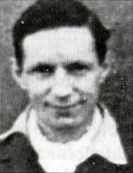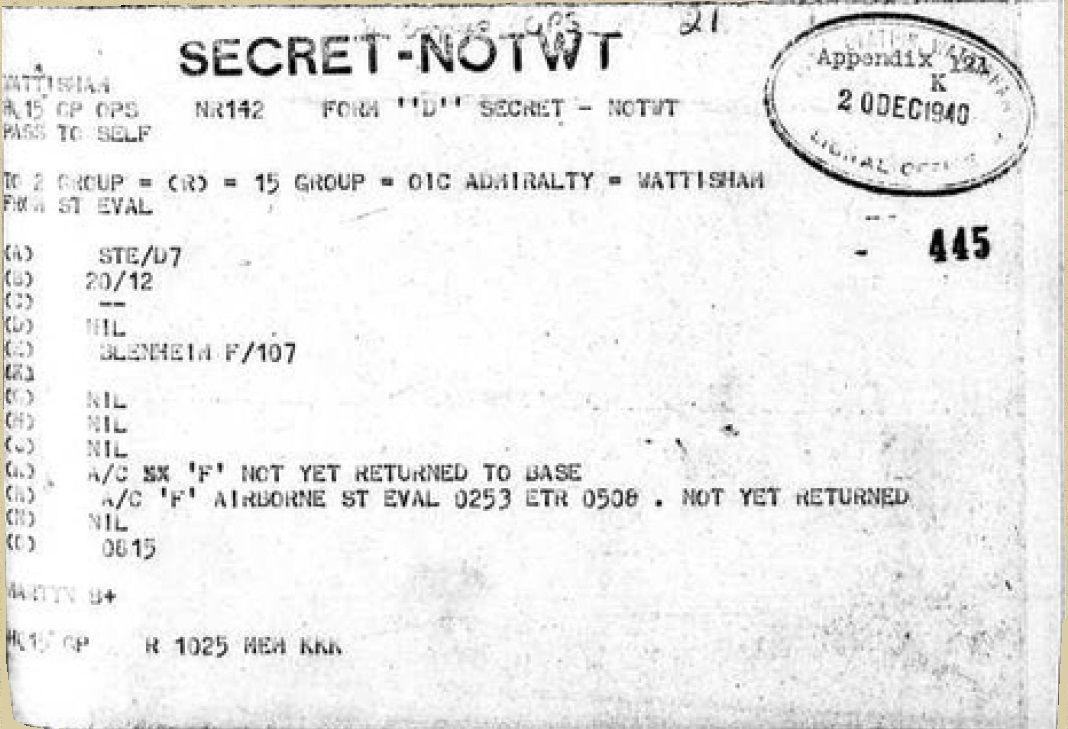Bristol Blenheim MkIV (T1860 - code OM-F)
"Loctudy", near de "Ker Pol Leo", Le Palais (Belle-Ile-en-Mer)
(contributors : Société Historique de Belle-Ile-en-Mer, Daniel Dahiot, Jean-Louis Roba, France Crashes 39-45)

Bristol Blenheim Mk IV of No. 107 Squadron (code OM-J) at Leuchars, Fife, Scotland
Photo : Imperial War Museum © IWM (CH 2428)
Crew (No. 107 Squadron RAF)
- Flight Lieutenant (pilot, at the rank of Pilot Officer that day) Edgar Spottiswoode HUMPHREYS,
RAF Volunteer Reserve, 29 years old, (service number 44177).
Born 5 Decembre 1914, son of William Spottiswoode and Lydia Humphreys, husband of Lilian Humphreys (nee Watt), of Oxford.
P.O.W. at Stalag Luft I then at Stalag Luft III (P.O.W. No. 406), escaped then killed on March 31, 1944 in Liegnitz
by Gestapo agents Lux and Scharpwinkel.
He was cremated and buried in Poznan Old Garrison Cemetery (8.C.5), Poland.
- Sergeant (observer) Geoffrey Royson GRIGGS, RAF (service number 581332)
P.O.W. (No. 431 - Stalag Luft 6)
- Sergeant (radio operator - air gunner) Leonard Frederick BRAND, RAF (service number 755736)
P.O.W. (No. 421 - Stalag 357)
THE STORY
On 20 December 1940, 7 aircraftS took off from RAF Saint-Eval [8 aircraftS had been detached from their RAF Wattisham base to RAF Saint-Eval to operate attacks on Brittany] including the Bristol Blenheim Mk IV T1860 (code OM-F) which took off at 2:50 am. Their targets were the airfields of Lannion (Côtes d'Armor) and Morlaix (Finistère). But the adverse weather conditions meant that only one aircraft was able to drop its bombs in the target area. The others returned to England with their bomb loads, apart from Flight Lieutenant Humpreys' aircraft.
An extract of a texte written in 2000 by Louis Chartier, Société Historique de Belle-Ile-en-Mer, letter # 28, mentions :

Smiling German soldiers pose on the wreck of Blenheim T1860 after its crash landing on the island of Belle-Île-en-Mer.
Photo © collection Jean-Louis Roba
An English twin-engine aircraft in Loctudy
On Friday 20 December 1940, at around 11am, an English twin-engine aircraft crash-landed near the village of Loctudy (before landing it had flown over Le Palais several times, close to the rooftops), with its landing gear retracted and its fuel tank empty, after getting lost in the fog, it was said. It was a very foggy morning, a fog that had cleared by the end of the morning, when the aircraft landed. The landing was done in slightly undulating ground starting at the Gas Plant and ending at the "Chemin de Loctudy-Bruté" ; today the ground is wooded but at the time it was quite clear. The aircraft had stopped at the top of Loctudy near Kerpold-Léo. The inhabitants of the neighbouring villages are said to have seen the three members of the crew trying to set fire to the aircraft but failing ; for others it was simply the flight's papers that they would have burned.

Blenheim T1860, of No. 107 Sqn RAF after its forced landing on Belle-Île-en-Mer.
The appearance of the German soldier suggests that he is taking a picture of the aircraft.
Photo © collection Jean-Louis Roba
The departmental archives of Morbihan give several dates (December 20, 21, 23 and 24, 1940), these successive dates are certainly due to the fact that this aircraft remained on the ground for more than 2 weeks. According to JG "It was the Friday before the Christmas holidays". Yvonne Lanco in her book "La Citadelle de l'Atlantique" specifies the date : December 20, 1940. Note that 12/20/40 was indeed a Friday. The departure of these English airmen within half an hour of landing generated a mini demonstration of sympathy on the quay, their departure was punctuated by a few "Good Bye ! We'll get them !" to the great anger of the occupants ? This demonstration should be put into perspective, some Bellîlois historians having a marked propensity for exaggeration.
The admiring "Belle-Iloises" (i.e. women of Belle-Ile).
The young ladies found these English airmen very much to their taste. "Ah ! They were so handsome ! They had a beautiful white turtleneck sweater, a beautiful jacket with sheepskin in it and beautiful boots with sheepskin in them too." Were some of them who were already "practicing" the Wermacht and the Kriegsmarine ready to fall into the arms of the RAF ? Probably, there is nothing you can do against the attraction of the uniform.

The crew of Blenheim T1860, from No. 107 Sqn RAF, after being captured by the Germans,
probably waiting to board for the continent.
The faces are relatively relaxed, no doubt happy to have escaped the crash landing alive.
Photo © collection Jean-Louis Roba
This twin-engine aircraft, crew of 3 men, with a rather strange glass front, in the shape of a barge's bow, was perhaps a Blenheim. It remained for more than two weeks in this field in Loctudy, guarded day and night by a sentry, until the arrival of specialists from Lorient who dismantled it part by part. The boxes of these parts were then stored at Le Palais, quai de l'Yser. The kids in the neighborhood all had a nut, a washer, relics in their pocket ! In Bordustard as in Loctudy, it was the Sunday walk of the people of Belle-Ile and that of the students of the public school during the week.

German experts from Lorient dismantle the parts of the Blenheim T1860
Photo © collection Jean-Louis Roba
In the list* kept almost daily of the losses of the English bomber aviation for the month of December 1940, we find on the date of December 19-20 the loss of a Blenheim IV type aircraft; the three crew members being taken prisoners of war :
Aircraft loss report** :
Date : 19-20/12/40
Mission : Lannion
Type : Blenheim IV
Unit : Sq 107
Registration : T 1860 M
Crew :
F. Lt E.S.Humphreys, POW
Sgt G.R. Griggs, POW
Sgt L.F. Brand, POW
Note : Takeoff from Watisham to attack Lannion airfield |
The place of the crash is not specified.
Is this the aircraft lost following an operation over Brittany ? Probably, Lannion being about 150 km from Belle Île, a compass failure added to this thick fog would explain the crash landing at Belle Île. The RAF fighter aviation did not suffer any twin-engine losses for this period. To be certain that this is indeed the aircraft, consultation of the archives of losses of the reconnaissance aviation and the RAF Coastal Command would be necessary.***.
From Loctudy to the Gestapo bullets ?
Flight Lieutenant Humphreys, pilot of this Blenheim, took part in the mass escape from Stalag Luft III in March 1944, he was captured and murdered by the Gestapo on 31 March 1944, his remains now rest in the Old Cemetery in Poznan (Poland).
* Departmental archives of Morbihan, réf. M13248
** ‘’Bombers command losses’’ W. Chorley - Midland Counties Publications
*** The examination of the Operational Record Book of No. 107 Squadron carried out after the publication of this newsletter "Belle-Ile Histoire No. 28" confirms the loss of the aircraft (see appendices below).
EDGAR SPOTTISWOODE HUMPHREYS
(source Wikipedia)

Edgar Spottiswoode HUMPHREYS
Photo © The Pegasus Archives
Born on 5 December 1914 in Exmouth, Devon, Edgar was the eldest child of Lydia and William Spottiswoode Humphreys. He attended the local school and developed an early interest in aviation. In 1931, at the age of 16 and a half, he passed the tests for a Class A pilot's licence, which could only be obtained at the age of 17. He joined the RAF in 1932 with 25th Entry of Apprentices at No 1 School of Technical Training RAF, RAF Halton, and graduated in 1935 as an aircraftman 2nd class (service number 565906 at the time). After working as a ground crew, Humphreys applied and was accepted for pilot training. He was promoted to Sergeant after gaining his wings.
With the beginning of the war, Humphreys became a Pilot Officer on 19 July 1940 with seniority to 25 April 1940 (see London Gazette in appendices) and his service number became 44177. He married Lilan Watt in the early summer of 1940 near Okehampton, Devon, and they settled at Boscombe. He flew Blenheim light bombers with No. 107 Squadron RAF from RAF Wattisham, after their return from the Battle of France. The first missions were to attack German targets in occupied territory : airfields, harbours, troop installations... On the night of 15/16 November 1940, he survived the crash of his Belnheim Mk IV aircraft "R3737" at Stowmarket, while returning from a bombing mission.
After being sent from RAF Wattisham to RAF St. Eval, Humpreys took off on 20 December 1940 to attack Lannion airfield in Brittany. As we know, the aircraft made a forced landing, possibly after being hit by naval anti-aircraft fire, and the crew was captured. He was prisoner No. 406 and was sent to Stalag Luft I Barth. On 19 July 1941 he was promoted to Flying Officer and a year later to Flight Lieutenant.
At Stalag Luft I, Humpreys, nicknamed "Hunk", met Roger Bushell, with whom the escape tunnel adventure began. Humpreys, Bushell and a few others were sent to Stalag Luft III in Lower Silesia, near Sagan. On the night of 24-25 March 1944, Humphreys was among 76 escapees from the camp, along with F/L Paul Royle, who was shot down on 17 May 1940 [Royle was captured after his escape but was not executed]. Humpreys was number 54 in the escape line and Royle was number 55. After walking south through the snow and cold, they were arrested 24 hours after their escape near the village of Tiefenfurt. Humpreys and other captured airmen were taken to the civilian prison at Sagan. They were then taken to Görlitz prison. On 31 March 1944, Keith Ogilvie (a Canadian airman from No. 609 Squadron) saw Humphreys and a few others being taken away in trucks. They were shot by the Gestapo in a clearing on the road from Görlitz to Sagan. Humphreys was later cremated at Lignitz by the Gestapo. His ashes were buried first in Sagan and then in the Old Garrison Cemetery in Poznan.
IN MEMORIAM
♦ Memorial of the "Fifty" along the road to Sagan (today Żagań).

Humphreys' name appears on the right in the 2nd line (yellow arrow).
Photo CSvBibra - Public domain
APPENDICES
♦ Operational Record Book of No. 107 Squadron for the date of 20th December, 1940
(source documents : The National Archives)
- Document AIR-27-841-30

- Document AIR-27-841-31

- Document AIR-27-848-03

In this document, it is specified that the Blenheim coded "F" took off at 2:53 a.m. and twice,
it is mentioned that he had still not returned ("not yet returned").
♦ The London Gazette :
- London Gazette of August 6, 1940 announcing Humphreys' promotion to the rank of Pilot Officer

- London Gazette of January 13, 1942 announcing Humphreys' promotion to the rank of Flying Officer on 19 July 1941 with seniority to 25 April, 1941.

- London Gazette of July 24, 1942 announcing Humphreys' promotion to the rank of Flight Lieutenant on 19 July 1942 with seniority to 25 April, 1942.

Ajouter un commentaire